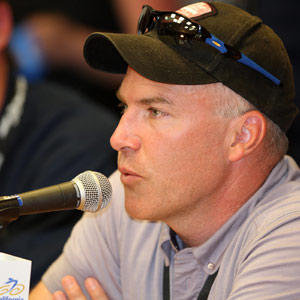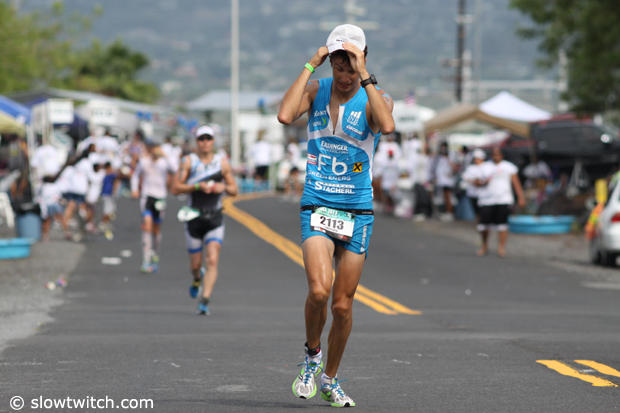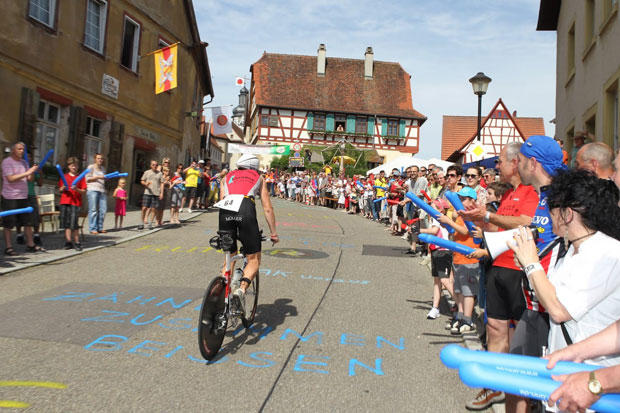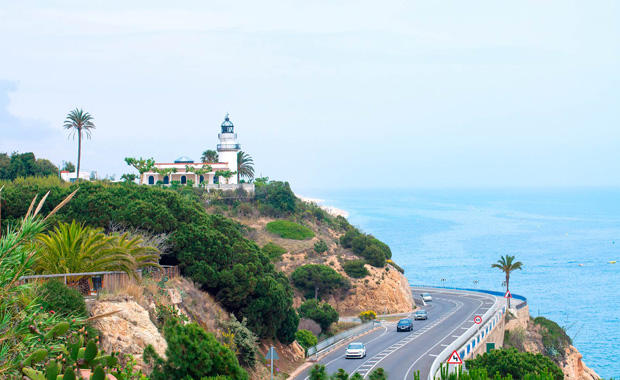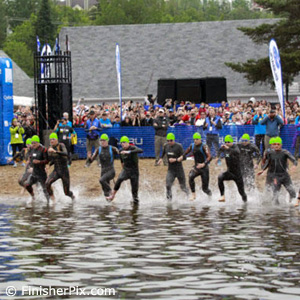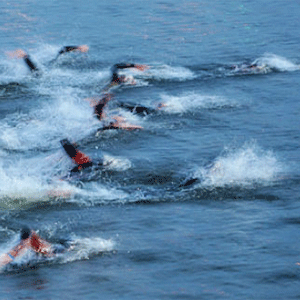Messick explains the changes
Andrew Messick is piloting the Ironman Corporation during its period of greatest growth. And with that growth comes some choices and adaptations that affect the entire sport. Recently, Messick announced changes to the Ironman World Championship swim start waves and a fairly radical redistribution of professional prize purses. During a press briefing last weekend before Ironman Boulder, Messick spoke in depth about the philosophy and thinking behind the moves.
Slowtwitch: What has caused Ironman to make some changes in your start waves at Kona and with your pro prize purse and world championship qualifying points structure?
Andrew Messick: Our business has changed pretty substantially in recent years. We are on track to have north of 200,0000 registered athletes from the 28 countries that race with us in 2014. In Ironman 70.3 we added 24 races. We are now at a point, between Ironman and Ironman 70.3 races, we have 110 events around the world on six continents and 27 countries. And the growth of our business and the growth in the number of races has caused us over the past 9 months to take a fairly fundamental relook at a couple of aspects of our business.
As we have gotten bigger, and as we have found that we have started putting more races in different parts of the world and we have started to tap into pools of athletes and the combination of different places and territories has caused a fairly substantial increase in the overall level of quality of athletes at the Ironman World Championship. And this has manifested itself in a couple of ways that are profoundly affecting the Ironman World Championship.
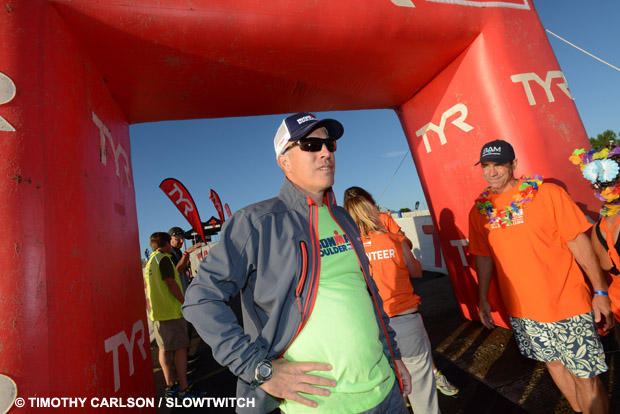
ST: What has made you respond to increasing congestion among the faster age groupers?
Andrew: We have an extraordinary concentration of remarkably good swimmers in Kona. At our peak exit into the first transition in 2013, we had just under 1170 athletes get out of the water in a 15 minute period – including just under 500 athletes getting out of the water in one 5 minute period. So there is an extraordinary density of athletes getting out of the water and on the bike course. If you put 500 athletes on to the bike course in 5 minutes, there is no way you can maintain a 12 meter gap between them.
ST: So why do you think you had to make the biggest adjustment for the female age groupers?
Andrew: The density on the bike course is a function of too many remarkable strong swimmers. And this particular issue has profoundly influenced the female age group race. The strong female swimmers are able to get strong drafts on the swim. After that, they are able to exit out of the water and get out onto the bike course within larger groups of men. We will address this by instituting a separate age group women's start. Starting in 2014, pro men will go at 6:25, pro women will go at 6:30, age group men will start at 6:50 and age group women will go at 7 AM. We believe that by separating the age groups we will decrease the density, spread out the bike course, and give women an opportunity to have the cleanest race we can provide them
ST: Why have you eliminated many pro purses at Ironman and Ironman 70.3 events later in the year starting in 2015?
Andrew: It has been clear that as we have added races in the last two years – those races have disproportionately been in September and October and November. For all of those races we followed our standard modality — when we added a race, we announced a prize purse. What we are increasingly coming to believe is that we are over fragmenting our prize purses. In particular we are putting too much of our prize money into a time of the year when we don’t have Kona qualified athletes competing.
So in 2015, we will be changing. This is largely a North American phenomenon, but it will manifest itself to smaller extents elsewhere. Going forward, we will have 9 North American Ironman races that will not have prize purses, will not have pro prize points, and will not be races where professionals can validate for Kona. At same time, we will be having 11 Ironman 70.3 races that will not have pro prize purses and will be age group only races. All of the prize money we are taking out of those races will be redirected into larger prize purses at the races where we will have pro prize purses.
ST: What good will this do?
Andrew: We believe this will concentrate more of the money in 2015 into the hands of the most successful, most competitive athletes. And we think on a philosophical basis, the people who are winning and competing at the highest level are the ones who should disproportionately secure the larger share of the pro prize money. We feel that the pendulum has swing too far in the other direction recently. Partly because we kept adding races and every time we added a race we put prize money with it, even if those races were races where no top professionals showed up.
ST: Will you be shrinking prize purses across the board?
Andrew: By and large we rarely decreased prize purses when we added races. We simply added to it. Next year it will be up 3.7 percent from $4.9 million to $5.1 million total prize purses. Our intention is to make sure that who gets it [the most competitive, most prominent athletes] — that will change a lot.
ST: Why have you added so many late season races and removed pro prize purses and KPR points largely from these races?
Andrew: There is great resonance among age group athletes to do their Ironman races in late September even October and November. Because most age groupers are able to train in the summer. So we see over-demand from age group perspective late in the season. And in that is the time when the charismatic high performing pro athletes are not going to race those races. And so if you look at Wales, Wisconsin, Tahoe. Mallorca, Malaysia Chattanooga, Barcelona – none of those races will one Kona pro. Not one. And so if pro prize money is going to be allocated to those races, as has been done in 2014, it would go to people who are not among the top 55 men and the top 35 women. We think it is better for the sport to help the earnings of the people who are going to be competing [at Kona]. So the money is being shifted forward in the calendar year.
ST: To what extent will you offer deeper prize money?
Andrew: All of championship races and all the races that have prize purses in excess of $75,000 will pay 10 deep. We have some smaller races – Malaysia will have a $40,000 prize purse, and we will have some other ones [at that level]. But as a rule, for either a 70.3 or a full Ironman, if it has a $75,000 or greater total purse, we will pay 10 deep. It was our conscious decision to get the biggest athletes into the biggest races and to provide an incentive for more of those athletes to show up. Even if they have a bad day, they will still get a paycheck.
ST: What about nurturing up and coming athletes?
Andrew: There will still be races with paydays later in the season. So, Ironman Malaysia, Ironman Chattanooga, Barcelona and Mallorca will still have a payday. Florida will not have prize purse. But we will increase Arizona.
ST: What will impel you to increase the number of women pros?
Andrew: It is interesting. We had a meeting with several female pro triathletes here in Boulder this past week. The women we talked to yesterday – a really good group — were not at all focused on the number. They just wanted the numbers for men and women to be the same. They didn’t particularly care if it was 55 or it 50 or 40 or 30. They felt as a fundamental matter of fairness the number should be the same. So we will look at it for 2015.
ST: Will you keep the number of men at 55?
Andrew: If we change the number of women, that that might result in fewer men. So we will start the deliberation process without an absolute ingoing assumption that we need to raise the women pro field to 55. Rather we will determine what is the right number of professional athletes that should be starting an Ironman World Championship.
ST: How will that change the process and the result of the Kona and Ironman 70.3 World Championship qualifying processes?
Andrew: All of a sudden you are shrinking the number of races that have points by a lot. And you are concentrating the number of athletes that will be racing one another. So how that manifests itself within the KPR system is something we just don’t know at this point. It may result in a change in the people qualifying for Kona – or not.
ST: What if anything was the influence on your pro prize money redistribution by The Real Starky campaign crowd-funding 7th place prize money at Lake Placid?
Andrew: This process has been going on a long time. We had decided well before any of that happened that there would be no pro prize purse in 2015 at Lake Placid. So whether this year we paid to 6th or paid to 8th, our view is Lake Placid is one of the great age group races in the world. That is its heritage. That is what it will continue to be. The Real Starky is not responsible for us killing the pro prize purse at Lake Placid.
ST: Ever think of devoting some prize money or substantial awards for amateurs as Rev3 has done?
Andrew: We've never taken a serious look at paying age group athletes. We think that competitive age group athletes are remarkably focused on qualifying for the Ironman World Championship and, increasingly, qualifying for the 70.3 World Championship. And a few dollars beyond that we feel is not super relevant. What we see everywhere in the world is the percentage of athletes who automatically qualify for spots at Kona going up. We find that the slots are rolling down less. And there is ever-increasing demand. And we endeavor and are using all of our tricks to find additional ways to get athletes into those races.
ST: What expansion of Ironman and Ironman 70.3 races do you see in the future?
Andrew: We are thinking about what the next 3 to 5 years will bring. We still have two full distance races in South America. We still don’t have a full distance race in Italy. We don’t have a full distance race in the Middle East. We don’t have a full distance race in eastern Europe. We have a full distance race in Malaysia. We will have one in 2015 in Taiwan. We have one in Japan [Hokkaido]. But there continues to be huge parts of the world where we know there are athletes because they race with us [in existing Ironman races]. For example, there are 200 Mexican athletes racing in Boulder tomorrow. And Luis Alvarez says he will bring 400 Mexican athletes to Barcelona next year. And so there are strong pockets of age group athletes all over the world. We watch what happen at ITU Worlds and see that there are vibrant country level teams in many places where we have no presence whatsoever. We know that over time long distance athletes will develop in those regions. And over time nothing develops long distance athletes faster or better than putting a race there.
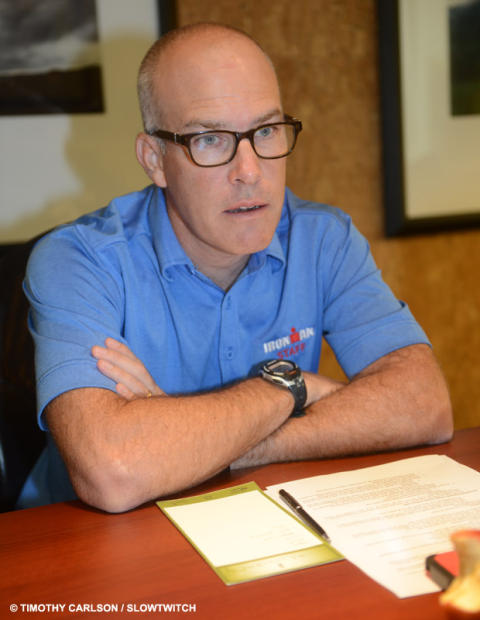
ST: Do you see the demand for Ironman races leveling off?
Andrew: As we think about the increasing demand for capacity at the Ironman World Championship and increasingly at the 70.3 World Championship, we expect that demand is only going to grow. And that creates a whole series of operational operational headaches you are really happy to have. But there remains a lot of the world that has not been fully exposed to Ironman. And it is our intention to do that in the coming years.
ST: Have you learned anything from or been inspired by or analyzed the effects created by places that have offered top prize purses for professionals such as Life Time Fitness, Hy-Vee, and now this new race in the Middle East?
Andrew: We think that if you put on a race with a large pro purse you will get a spectacular pro field. That is the first thing. The pro field at Hy-Vee has been fantastic. And we expect that the race in December in the Middle East will have a spectacular pro field. The trick is not to do it. The trick is to keep doing it.
ST: What is your strategy for continuation of growth?
Andrew: We have been relatively conservative. And so we are very thoughtful about aggregate levels of pro prize money – about what we feel is in the long term sustainable for our business. There are a lot of people out there who have gone out and offered large pro prize purses. And not one of them has stuck. Maybe the next one will. But building a triathlon business requires vibrant age group racing. So spending a lot of money on professional triathletes – for that to work in the long term you have to be able to connect that pro race with vibrant age group racing. And that has been not consistently achieved over the years.
ST: Many pros have been asking to be consulted when you are making decisions about Ironman and Ironman 70.3 pro racing.
Andrew: We have been talking to a lot of pros independently. But one of the problems we encounter is there is no representation. Not one voice representing all of them that we can talk to. The opportunity for us in the future is felt there ought to be a counter party that we can talk to that actually represents the voice of the professional triathletes. I know over the years there have been various attempts. It would be enormously important for us to have a small group of people who represented that pool of pro athletes. And we would welcome that. At this recent meeting here in Boulder, we told them that. I think they left motivated to try to find a structure that will work.
ST: How do you communicate with the pros right now? And how might that change?
Andrew: We want a way to have pros be more deeply involved in the decisions that we make. Paula Newby-Fraser and Heather Fuhr, are the people who on a day to day basis are interacting with professionals and do much of the spade work when we think about matters like prize money. They are quite dialed in to what goes on. But they will be the first to say that the answer you get to the question depends on who you are talking to – and their particular circumstances. But we would welcome a counter party. That would make our lives a lot easier and if that happened we feel we would all end up in a better place.
ST: If you cut down the number of your races offering a pro purse, fewer people can contend for that pot. Do you anticipate that this will shrink the number of pros because they will have a harder time making a living?
Andrew: You would think so but I don’t know. We don’t know why people choose to be professional triathletes. To be a professional triathlete within our system you have to be designated by a national governing body. You need to be a professional licensed by us. Those are the two process steps that place you as a pro athlete. According to sources, there are 1,100 pro triathletes. And every one of them is doing it for their own reasons. I don’t know why Rachel Joyce is a professional triathlete as opposed to practicing law. She is lawyer. I am not sure why Amanda Stevens is a professional triathlete as opposed to practicing medicine because she is a doctor. I am not sure why Meredith Kessler left working in finance. But I trust that all of them had a good reason for it. And that they chose being a professional triathlete because that is how they wanted to live their life. Hopefully, that choice provides them a combination of benefits and money, [and advantages based] around flexibility and chasing a dream that made it worth it.
ST: It’s a pretty low percentage of pros who can make a living at it
Andrew: I don’t know why there are 1100 pro triathletes because I know 1100 professional triathletes do not all earn a living [entirely from the sport]. Probably 900 of them don’t earn a living. But for their own reasons they have chosen to be pros. And we are not in the business of evaluating who should or who should not be a professional triathlete. So I would expect as the earning opportunity gets more concentrated towards the tip of the pyramid, there would be fewer pros. But because I don't really know why many are doing it, I can’t guarantee that. I wish I had a good answer to that.
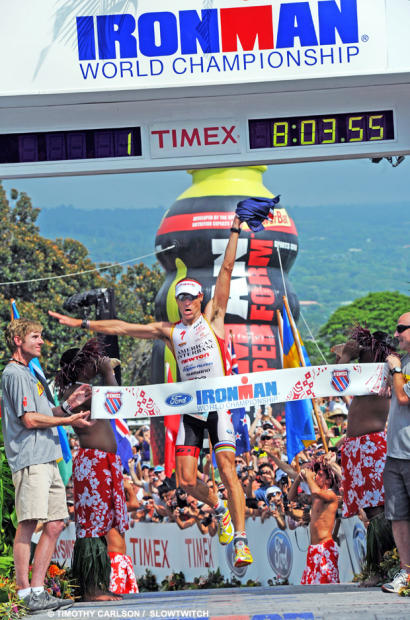
ST: What in your mind do the pros contribute to your bottom line?
Andrew: I don’t know the answer to that. But whatever it is I’d like it to be higher. My professional experience has been with professional basketball and professional cycling. And I have seen that the role of the professional athlete is dramatically enhanced relative to the success of the business of that sport. I think and I have said this from the day I walked into the door: I believe that our top tier professional triathletes should be more famous than they are. They should make more money than they do. They should be more relevant and they should have higher profile among the media, in the host cities, and among the age group triathletes. How we do that is something that collectively we have yet to figure out. But we would like it to happen. Because that is one way to make the pie bigger.
ST: What responsibility does the WTC bear for the fact that their pros get less money than they deserve and less money than other sports? What part does the WTC play in that dynamic?
Andrew: Our business has historically been an age group business. And the age group athletes are what pay the salaries of the staff of this business. That isn’t answering your question. I understand that. But I think there is opportunity for everybody to increase the level of influence and atmospherics around the pros.
ST: Can you give us an example of what you think pros can do to increase their level of influence?
Andrew: I will give you two contrasting examples. The contrast between the two is relevant and germane to this conversation. Last weekend one of our former world champions validated for Kona at the largest triathlon in one of the world’s five financial centers. And that athlete went 11:42 with a 51 minute swim, 5 hour and 37 minute bike and a 4:56 run. [Messick was referencing 2012 Ironman World Champion Pete Jacobs of Australia who was validating his 2014 Kona entry at Ironman Switzerland in Zurich] There was never any doubt that this was simply punching a ticket.
ST: What is the counter?
Andrew: When I ran the Tour of California, Tom Boonen came almost every year. Boonen organized his year around the cobble classics, the Tour de France and at times the world championships. But he was a two peak [per year] guy. He was in phenomenal shape on April 10. He then did not get on a bike for 3 weeks. He came to the Tour of California [in May] and he was not fit. But he knew it. We knew it. Patrick Lefevere, who ran that team, sent Boonen, with 10 kilometers left in the sprint stages, to go to the front with his guys. If you look at the pictures of Tour of California sprint finishes, there was Boonen getting beat by Mark Cavendish. There was Boonen getting beat by other top sprinters. Tom Boonen is a professional. He was not in [peak] shape but he goes to a race and he tries. And there is the contrast.
ST: Because of your Kona validation requirement, two-time Ironman World Champion Mirinda Carfrae completed the 2013 edition of Ironman Florida as 28th place woman in 9:48:07 and husband-to-be Tim O’Donnell followed his 5th place at Kona with a 66th overall place in 9:15:54. What did you think of that?
Andrew: Like Tom Boonen, they were not in peak shape but they tried and they gave a professional performance.


